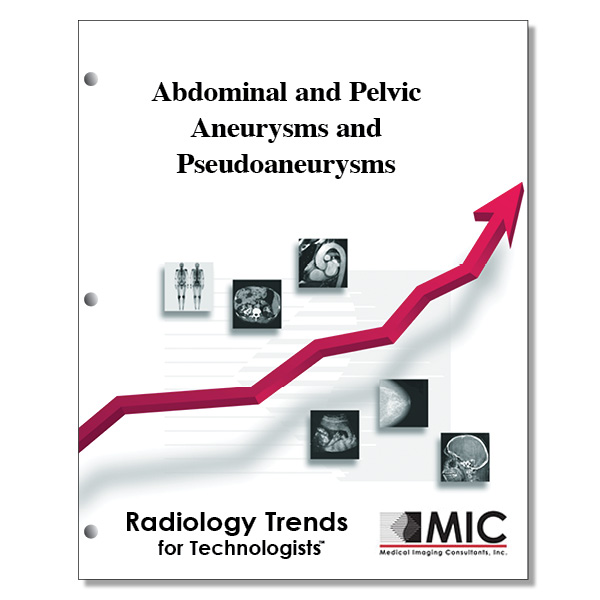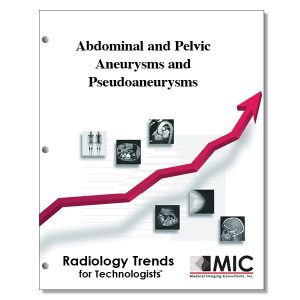

Abdominal and Pelvic Aneurysms and Pseudoaneurysms
Medical imaging and minimally invasive intervention of vicseral aneurysms and pseudoaneurysms are presented.
Course ID: Q00379 Category: Radiology Trends for Technologists Modalities: CT, MRI, Sonography, Vascular Interventional3.75 |
Satisfaction Guarantee |
$37.00
- Targeted CE
- Outline
- Objectives
Targeted CE per ARRT’s Discipline, Category, and Subcategory classification:
[Note: Discipline-specific Targeted CE credits may be less than the total Category A credits approved for this course.]
Computed Tomography: 2.00
Procedures: 2.00
Abdomen and Pelvis: 2.00
Magnetic Resonance Imaging: 2.00
Procedures: 2.00
Body: 2.00
Registered Radiologist Assistant: 3.75
Procedures: 3.75
Neurological, Vascular, and Lymphatic Sections: 3.75
Sonography: 2.00
Procedures: 2.00
Abdomen: 2.00
Vascular-Interventional Radiography: 3.75
Procedures: 3.75
Vascular Diagnostic Procedures: 3.75
Vascular Sonography: 2.00
Procedures: 2.00
Abdominal/Pelvic Vasculature: 2.00
Outline
- Introduction
- Visceral Artery Anatomy
- Imaging Tools
- Ultrasonography
- Computed Tomography
- MR Imaging
- Imaging Diagnosis of Aneurysms and Pseudoaneurysms
- Endovascular Treatment Principles
- Follow-up Imaging
- Abdominal Aneurysms and Pseudoaneurysms
- Splenic Artery Aneurysm
- Splenic Artery Pseudoaneurysm
- Hepatic Artery Aneurysm
- Hepatic Artery Pseudoaneurysm
- SMA Aneurysm
- SMA Pseudoaneurysm
- Celiac Artery Aneurysm
- Celiac Artery Pseudoaneurysm
- PDA and GDA Aneurysms
- PDA and GDA Pseudoaneurysms
- Gastric Artery Aneurysms and Pseudoaneurysms
- Renal Artery Aneurysm
- Renal Artery Pseudoaneurysm
- Multiple Abdominal Aneurysms
- Pelvic Aneurysms and Pseudoaneurysms
- Conclusion
Objectives
Upon completion of this course, students will:
- determine the difference between a true aneurysm and a pseudoaneurysm
- discuss the complications of true aneurysms
- determine the indication for treatment of pseudoaneurysms
- differentiate the functions of the layers of the arterial wall
- determine the characteristics of fusiform aneurysms
- explain the causes of true aneurysms
- determine the terms synonymous with pseudoaneurysm
- identify the collateral pathways from the SMA to the celiac artery
- identify the arterial branches of the celiac trunk
- determine the organ supplied by the gastroepiploic arteries
- identify the limitation of ultrasound in the imaging of visceral arteries
- determine the phase of the CT scan in which the CT angiographic images are obtained
- identify the factors related to contrast enhancement of CT arterial images
- discuss the advantage of MR imaging over CT imaging
- determine the slice thickness for CTA reconstruction
- determine the potential complication for gadolinium and patients with compromised renal function
- describe the characteristics of visceral artery aneurysms on US imaging
- describe the characteristics of pseudoaneurysms on radiology images
- discuss the advantages of angiography in the diagnosis of visceral artery aneurysms
- explain how peristaltic motion can be controlled during angiography
- identify the equipment used to sub-select an artery for embolization
- define embolization
- determine what materials are cast forming agents
- define sac-packing
- determine the indications for the sandwich coiling technique
- determine the desirable scenarios for use of “cast-forming” agents
- identify the type of aneurysm in which a stent graft would be indicated for treatment
- discuss which embolization technique should be avoided as the sole treatment of pseudoaneurysms
- describe the potential adverse finding on post-embolization follow-up imaging
- describe the indications for treatment of visceral artery aneurysms
- discuss the associated factors in splenic artery aneurysm formation
- determine the fetal morality rate associated with splenic artery aneurysm
- identify the typical symptoms of hepatic artery aneurysms
- identify procedures that cause an increased incidence of hepatic artery pseudoaneurysms
- identify differences in presentation of patients with SMA aneurysms
- describe the factors that cause SMA pseudoaneurysm formation as a result from pancreatitis
- describe the causes of multiple abdominal aneurysms
- identify the characteristics of mycotic aneurysms
- discuss the vascular effects of Marfan syndrome
- determine why conventional angiography is contraindicated in patients with Ehlers-Danlos syndrome
